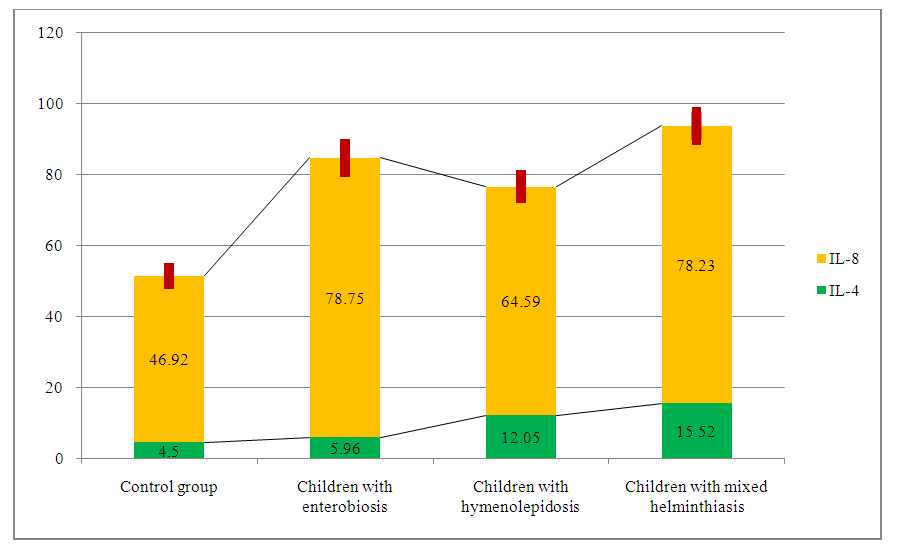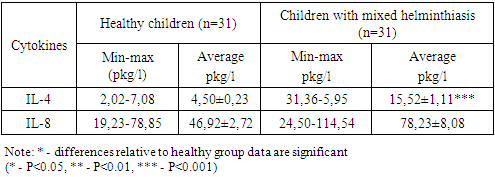-
Paper Information
- Paper Submission
-
Journal Information
- About This Journal
- Editorial Board
- Current Issue
- Archive
- Author Guidelines
- Contact Us
American Journal of Medicine and Medical Sciences
p-ISSN: 2165-901X e-ISSN: 2165-9036
2024; 14(2): 173-175
doi:10.5923/j.ajmms.20241402.01
Received: Dec. 20, 2023; Accepted: Jan. 28, 2024; Published: Feb. 2, 2024

Cytokine Profile of Preschool Children with Helminthiasis
Mukhiddinov Shuxrat Toirovich, Mukhamedova Shaxnoza Tolibovna, Bahranova Dilshoda Tohirovna
Bukhara State Medical Institute, Uzbekistan
Copyright © 2024 The Author(s). Published by Scientific & Academic Publishing.
This work is licensed under the Creative Commons Attribution International License (CC BY).
http://creativecommons.org/licenses/by/4.0/

The authors studied in detail the cytokine profile of children with different types of helminthiasis, and compared it with the results of healthy children. The results showed significantly high values of IL-8 in enterobiosis, in the group of mixed invasions there was a three-fold increase in IL-4 against the background of a twofold increase in IL-8.
Keywords: Hymenolepidosis, Enterobiosis, Helminthiasis, Children
Cite this paper: Mukhiddinov Shuxrat Toirovich, Mukhamedova Shaxnoza Tolibovna, Bahranova Dilshoda Tohirovna, Cytokine Profile of Preschool Children with Helminthiasis, American Journal of Medicine and Medical Sciences, Vol. 14 No. 2, 2024, pp. 173-175. doi: 10.5923/j.ajmms.20241402.01.
1. Introduction
- Helminthiasis is a group of diseases caused by parasitic worms (helminths). Children's helminthiasis is an actual pediatric problem. It is faced not only by specialists of the relevant profile (infectious disease specialists, epidemiologists, parasitologists), but also by medical workers of the district service, preschool and school institutions, hospitals and centers of sanitary and epidemiological surveillance. Human helminthiasis pathogens represent an extremely diverse group of animal organisms leading a parasitic lifestyle, a certain stage of development of which is carried out in the soil (geohelminths) or requires a change of host (bio helminths).According to the World Health Organization, intestinal helminths among parasites are in 2nd place after diarrhea-their frequency is more than 3.5 billion. cases per year. Experts of the World Bank put intestinal helminthiasis on the 4th place among the leading causes of damage caused by human diseases. At the same time, the importance of helminths in human pathology has been underestimated until recently. Helminths are one of the most ancient and numerous forms of life on our planet.The purpose of the study: To study the cytokine profile of preschool children with helminthiasis.
2. Materials and Methods
- In order to identify the prevalence of helminthiasis among 510 preschool children aged 3-7 years, worm infestations were detected in 194 (38%). All 194 children with helminthiasis made up the main group of clinical observations, 31 practically healthy preschool children were selected for the control group. All 225 examined children underwent general clinical, laboratory (general analysis of blood, urine, feces) and instrumental (ultrasound of abdominal organs: liver, gallbladder, pancreas and kidneys) methods of research.To increase the information content and quality of the anamnesis collection, a double questionnaire was conducted by interviewing parents /guardians of children in a preschool educational institution and at the reception of a pediatrician.
3. Results and Discussions
- The distribution of the groups of examined children was as follows: 1-control group consisted of 31 healthy children, 2-group consisted of 120 children with enterobiosis, 3-group – 43 children with hymenolepidosis and 4-group of 31 children with mixed invasions, i.e. mixed helminthiasis. Taking into account the influence of the above pathological conditions on the body of children, an immunological study was conducted to determine the cytokine status. The results of the immunological examination of children showed that a characteristic feature for children of the first group (children with enterobiosis) was a significant increase in the level of IL-4 - 5.96±2.2 pkg/l (p<0.001) compared with the control group - 4.50±1.2pkg/l, which is 1.3 times more, and IL-8 - 78.75±8.8 pkg/l relative to healthy children - 46.92±2.7 pkg/l, the concentration of which is 1.7 times higher (p<0.001) (Table 1).
|
|
|
 | Figure 1. Cytokine profile of children with helminthiasis |
4. Conclusions
- Thus, the reactivity of signaling systems of this type is associated with a high antigenic load and a combination of several types of parasites that cause local eosinophilic inflammation in the intestine and systemic allergic reactions. The study of the cytokine profile with the choice of pro-inflammatory IL-4 and anti-inflammatory IL-8 and the reliable results obtained justify the need for further, more extensive immunological examination of the infected children.
 Abstract
Abstract Reference
Reference Full-Text PDF
Full-Text PDF Full-text HTML
Full-text HTML

